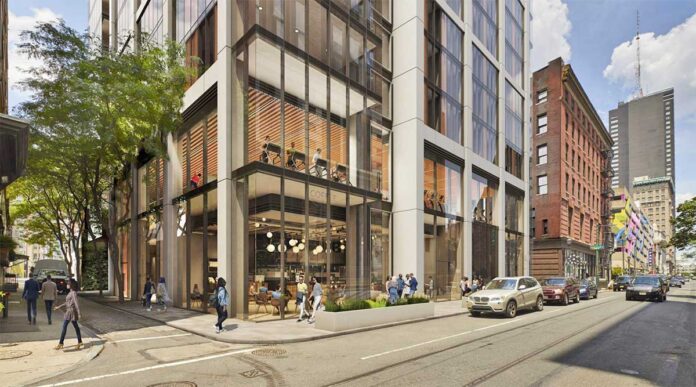Plans are underway for a high-rise condominium to be built on the site currently occupied by the empty 12th Street Gym in the Gayborhood. According to a Civic Design Review submitted in July 2020, the roughly 18,434 square foot, 31-floor building will contain 448 residential units, retail on the first three floors, and an underground garage of 68 parking spaces.
In early 2018, after 12th Street Gym closed due to financial hardship, developers announced that the building would be demolished and a new building put in place.
The development company, Midwood Investment & Development, also struck a deal with the city in 2018 to recreate the mural of Gloria Casarez currently emblazoned across the wall of the existing building. The mural will be recreated in a new location with financial assistance from Midwood, according to the company’s CEO John Usdan, though the new location of the mural has yet to be determined.
Casarez was an LGBTQ+ activist who served as the first director of Philadelphia’s Office of LGBT Affairs and headed the LGBTQ Latinx social justice organization GALAEI. She was deeply active in the community through other initiatives, such as the student and youth-led homelessness solutions organization Empty the Shelters and board membership of Prevention Point Philadelphia. After she passed away from cancer in 2014, artist Michelle Angela Ortiz created the mural to honor Casarez’s life.
“Early on we engaged with the Mural Arts Society and State Representative Brian Sims to make sure that the importance of the mural was taken into consideration,” Usdan said. “We indicated that we would be supportive of the relocation through our gift and working with Jane Golden to make sure that that was accomplished.”
Usdan also told PGN that the development company has had and will continue to have discussions with Chris Bartlett, executive director of William Way LGBT Community Center.
In a letter to Midwood Vice President Richard Young dated September 8, 2020, Bartlett and John Anderies wrote on behalf of Philadelphia’s LGBTQ communities expressing concerns about the recreation of the mural and the building itself.
“We are deeply concerned,” the letter reads in part, “that your plans to demolish 204 S.12th Street, and the mural on its facade, will serve to gentrify the neighborhood, and, paradoxically, homogenize the neighborhood in a way that will make it less appealing to all residents, including the future ones who may reside or work in your project.” Bartlett and Anderies also wrote “The mural is notable because it gives voice to people in our communities who are often voiceless: Black and Latinx LGBTQ people, transgender community members, and activists.”
Several other leaders in the LGBTQ community co-signed the letter, including Casarez’s wife Tricia Dressel, Alisha Berry, founder and director of Camp Sojourner, and David Acosta, founder of GALAEI and co-founder of the arts organization Casa de Duende.
“When you look at that mural, you see that what’s created on there are images of [Gloria’s] vision around fighting for social and economic justice across a broad spectrum of communities,” Acosta said.
Regarding the status of the new building, Midwood has gone through a zoning process and received a conditional approval, Usdan said. “There was outreach that had to be performed with both the city and the community. We are in discussions with all of our neighbors about the potential benefits and impacts that the development brings.”
Despite these discussions, members of the LGBTQ community who live and work in the vicinity of the forthcoming building site have expressed concerns similar to Bartlett’s.
“I am saddened and disheartened that I’m watching the Gayborhood that I know and love disappear,” said Elizabeth Coffey Williams, a resident of the John C. Anderson Apartments at 13th and Spruce streets. “It makes me wonder, how far is it going to go? Is it just going to continue until there is no more viable space for our community in our neighborhood? I’m certainly all for diversity and inclusivity, but it seems that not just for low-income seniors, but for many people, they’re just getting priced out of a vibrant and interesting portion of central Philadelphia.”
Demolition of the building that housed 12th Street Gym is set to take place toward the end of next year, Usdan said. He estimates that it will take roughly two and a half to three years to complete the new building.
“I can’t imagine 31 stories right where 12th Street Gym was, it just seems inconceivable,” said Larry Benjamin, director of communications for Mazzoni Center. “Given this administration is characterized by greed and their attempts to erase our community, for this developer to come in and do the same thing — tear down Gloria’s mural and then put in a building that’s not in keeping with the neighborhood, it’s symptomatic of the times we live in. [It] certainly upsets me and I would guess it upsets a lot of people in the community.”
Midwood is responsible for constructing other Philadelphia real estate, including the building at 15th and Walnut that houses the Cheesecake Factory. The forthcoming Gayborhood condo will be the first residential building in the U.S. designed by Rogers Stirk Harbour (RSHP) in collaboration with Philadelphia architecture company Bower Lewis Thrower (BLTa), Usdan said. RSHP architects have designed buildings worldwide, including the Centre Pompidou in Paris and 3 World Trade Center in New York City. BLTa is responsible for many Philadelphia buildings, such as The Bourse and the 28-story residential building at 36th and Market.
“It is our hope that we design and build not only one of the best residential buildings in Philadelphia, but one that will be well-regarded with all the stakeholders,” Usdan said.
According to Acosta, there needs to be more discussion when it comes to Midwood developing the Gayborhood building-to-be.
“Obviously we’re concerned about the mural and its potential demolition, and a very large multi-apartment, multi-use building going in its place,” Acosta said. “We’re also concerned about a sense of erasure of that neighborhood and its significance to LGBTQ history in Philadelphia. As far back as we can remember [that] has been the Gayborhood where most of our bars and institutions resided.”

